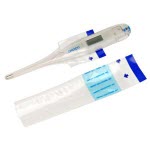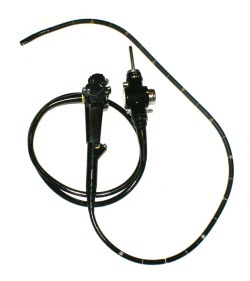Why Medical Devices Should Be Coated with Composites
 Everyone used to hate those scratchy, cellophane-like sleeves that went over the length of thermometers at the doctor's office when they took your temperature, right? Those plastic bag-like covers were the best defense -- working even better than rubbing alcohol -- at keeping thermometers germ-free. That is, until they developed smoother, fitted, rubber-like polyethylene (a composite material!) covers. Now, the composite covers keep germs from collecting on the thermometer's surface, leaving fewer germs to be removed in the first place. After all, an "ounce of prevention is worth a pound of cure."
Everyone used to hate those scratchy, cellophane-like sleeves that went over the length of thermometers at the doctor's office when they took your temperature, right? Those plastic bag-like covers were the best defense -- working even better than rubbing alcohol -- at keeping thermometers germ-free. That is, until they developed smoother, fitted, rubber-like polyethylene (a composite material!) covers. Now, the composite covers keep germs from collecting on the thermometer's surface, leaving fewer germs to be removed in the first place. After all, an "ounce of prevention is worth a pound of cure."
Fast Forward from the 1980s
 Composite thermometer covers have become so commonplace it seems we've forgotten they're even there. When was the last time you even paid attention as the nurse placed the cover on the thermometer? Indeed composite covers fit so well to the thermometers they seem to be part of the device itself. No more choking on scratchy cellophane seams. We know that composite materials perform amazingly on thermometers, so why aren't we using them on other medical devices?
Composite thermometer covers have become so commonplace it seems we've forgotten they're even there. When was the last time you even paid attention as the nurse placed the cover on the thermometer? Indeed composite covers fit so well to the thermometers they seem to be part of the device itself. No more choking on scratchy cellophane seams. We know that composite materials perform amazingly on thermometers, so why aren't we using them on other medical devices?
Go West …
 … To California and the outbreak of drug-resistant CRE (Carbapenem-Resistant Enterobacteriaceae) at UCLA's Medical Center, to Connecticut and the outbreak of E.coli at the Hartford Hospital, and superbugs are breaking out due to medical scopes. Literally across the country, there's an epidemic of highly infectious diseases being spread via these medical devices. It begs the question: Why don't all scopes have covers? Why aren't they covered with bacteria-inhibiting, composite materials?
… To California and the outbreak of drug-resistant CRE (Carbapenem-Resistant Enterobacteriaceae) at UCLA's Medical Center, to Connecticut and the outbreak of E.coli at the Hartford Hospital, and superbugs are breaking out due to medical scopes. Literally across the country, there's an epidemic of highly infectious diseases being spread via these medical devices. It begs the question: Why don't all scopes have covers? Why aren't they covered with bacteria-inhibiting, composite materials?
Introducing Anti-microbial and Antibacterial Composite Super-Materials
Composite materials have the wonderful capability of being infused with various anti-microbial agents -- from nano-silver, to colloidal silver, to different electrolytes, to biocompatible antibacterial formulae -- that kill or prevent the growth of bacteria. These chemicals can be imbedded into the composite casings of scopes or into disposable coverings, just like thermometers.
One of the main issues with the type of scope (a duodenoscope) involved in the drug-resistant CRE outbreak in California is that this scope has an 'elevator'-like head, allowing the camera at the end of the scope to be tilted at different angles for better image capture. The telescopic end of the scope allowed for germs to hide, even after sterilization efforts, among the smaller components.
These exposed components are great candidates for anti-microbial composite materials. Conceivably, a composite material can be used that stretches, yet is resilient enough to allow for the angled movement of the camera at the end of the scope, eliminating joints, and seams where germs could hide.
Globe Composite Solutions excels exactly at this type of challenge. For a similar requirement, our engineers created an anti-microbial gearbox housing used for food preparation using the natural antibiotic, nano-silver. Applying those same principles, skills, and ideas to other applications such as medical scopes would be a logical extension. If you’re interested in how Globe can help you, submit a project to us today.


